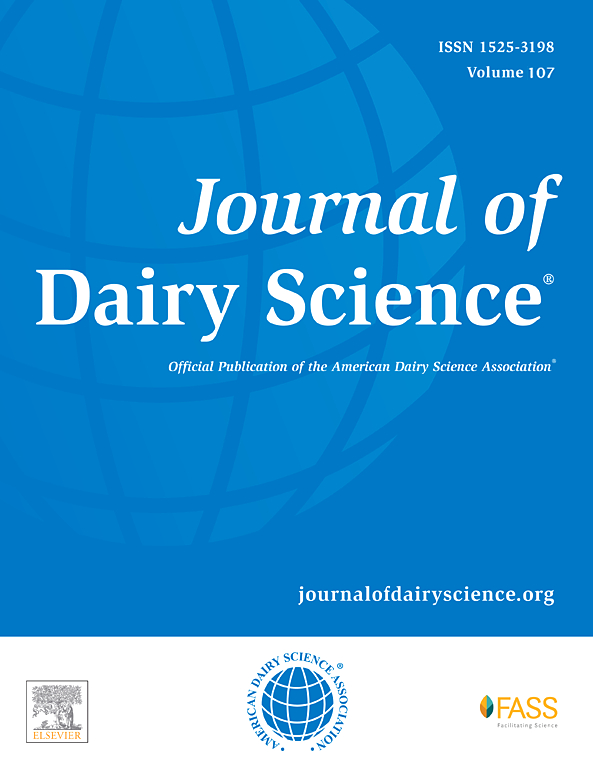Stage-specific milk yield losses and associated sweating, respiration, and rectal temperature responses under varying temperature-humidity index thresholds in lactating and dry cows
IF 3.7
1区 农林科学
Q1 AGRICULTURE, DAIRY & ANIMAL SCIENCE
引用次数: 0
Abstract
Heat stress (HS) may result in changes in the behavior, endocrine system, and physiological characteristics of dairy cows, and it may even lead to death in severe cases. As the effects of global warming have become more notable, the prevalence of HS has increased among dairy cows. Therefore, comprehensive strategies, including not only cooling measures but also dietary adjustments and genetic improvements for heat tolerance, are required to help these animals regulate their body temperature and avoid HS. In addition, detecting HS signs is essential for both lactating and dry cows to ensure appropriate interventions. The temperature-humidity index (THI) is a widely used tool for evaluating the effects of HS on livestock. Because the physiological state of cattle significantly influences their responses to HS, it is imperative to establish specific THI thresholds for both lactating and dry cows to implement appropriate cooling regimens and optimize animal welfare. In this study, we used the THI to investigate the relationship between rectal temperature (RT), respiration rate (RR), and sweating rate (SR) in lactating and dry cows. We also explored the relationships between milk yield at different lactation stages and THI thresholds. The results indicated that lactating and dry cows had different THI thresholds based on their immediate physiological responses. Compared with lactating cows, dry cows had higher THI thresholds for RT, RR, and SR. In addition, cows in early-, intermediate-, and late-lactation stages under thermoneutral conditions produced significantly more milk than did those under mild, moderate, and severe HS conditions, indicating that milk yield losses occur under HS conditions. Taken together, these findings provide valuable insights into how HS can be mitigated in subtropical dairy farms. For lactating cows, implementing cooling measures is recommended when the THI reaches 66 to 67, whereas for dry cows, waiting until the THI reaches 73 is recommended. Milk yield losses may occur when lactating cows are under HS conditions. Therefore, appropriate cooling measures should be implemented at accurate THI thresholds to ensure optimal animal welfare for both lactating and dry cows.
泌乳牛和干奶牛在不同 THI 阈值下的特定阶段牛奶产量损失及相关的出汗、呼吸和直肠温度反应。
热应激(HS)会导致奶牛的行为、内分泌系统和生理特征发生变化,严重时甚至会导致奶牛死亡。随着全球变暖的影响日益显著,奶牛热应激的发病率也在增加。因此,需要采取综合策略,不仅包括降温措施,还包括饮食调整和耐热基因改良,以帮助这些动物调节体温,避免HS。 此外,检测HS征兆对于泌乳奶牛和干奶牛都至关重要,以确保采取适当的干预措施。温湿度指数(THI)是评估高温热害对牲畜影响的一种广泛使用的工具。由于牛的生理状态会显著影响其对 HS 的反应,因此必须为泌乳牛和干奶牛建立特定的 THI 临界值,以实施适当的降温方案并优化动物福利。在本研究中,我们使用 THI 调查了泌乳牛和干奶牛直肠温度 (RT)、呼吸速率 (RR) 和出汗速率 (SR) 之间的关系。我们还探讨了不同泌乳阶段的产奶量与 THI 临界值之间的关系。结果表明,泌乳奶牛和干奶牛的即时生理反应不同,其 THI 阈值也不同。与泌乳奶牛相比,干奶牛的RT、RR和SR的THI阈值更高。此外,在恒温条件下,处于早、中、晚泌乳期的奶牛的产奶量明显高于处于轻度、中度和重度恒温条件下的奶牛,这表明在恒温条件下会出现产奶量损失。综上所述,这些研究结果为亚热带奶牛场如何缓解高温热害提供了宝贵的见解。对于泌乳奶牛,建议在 THI 达到 66 至 67 时采取降温措施,而对于干奶牛,建议等到 THI 达到 73 时再采取降温措施。当泌乳奶牛处于 HS 条件下时,可能会出现牛奶产量损失。因此,应在准确的 THI 临界值上实施适当的降温措施,以确保泌乳牛和干奶牛获得最佳动物福利。
本文章由计算机程序翻译,如有差异,请以英文原文为准。
求助全文
约1分钟内获得全文
求助全文
来源期刊

Journal of Dairy Science
农林科学-奶制品与动物科学
CiteScore
7.90
自引率
17.10%
发文量
784
审稿时长
4.2 months
期刊介绍:
The official journal of the American Dairy Science Association®, Journal of Dairy Science® (JDS) is the leading peer-reviewed general dairy research journal in the world. JDS readers represent education, industry, and government agencies in more than 70 countries with interests in biochemistry, breeding, economics, engineering, environment, food science, genetics, microbiology, nutrition, pathology, physiology, processing, public health, quality assurance, and sanitation.
 求助内容:
求助内容: 应助结果提醒方式:
应助结果提醒方式:


